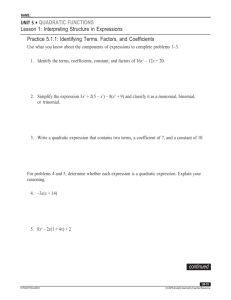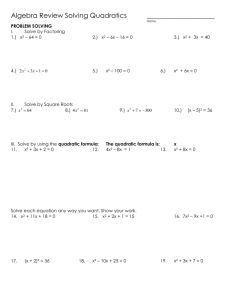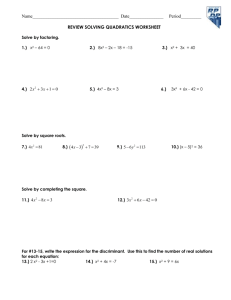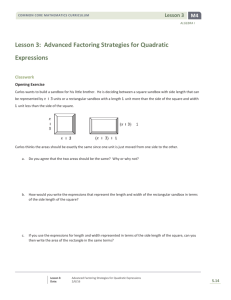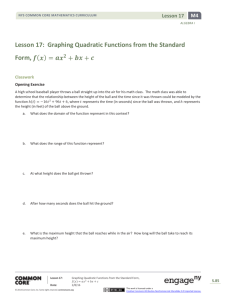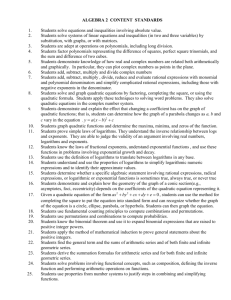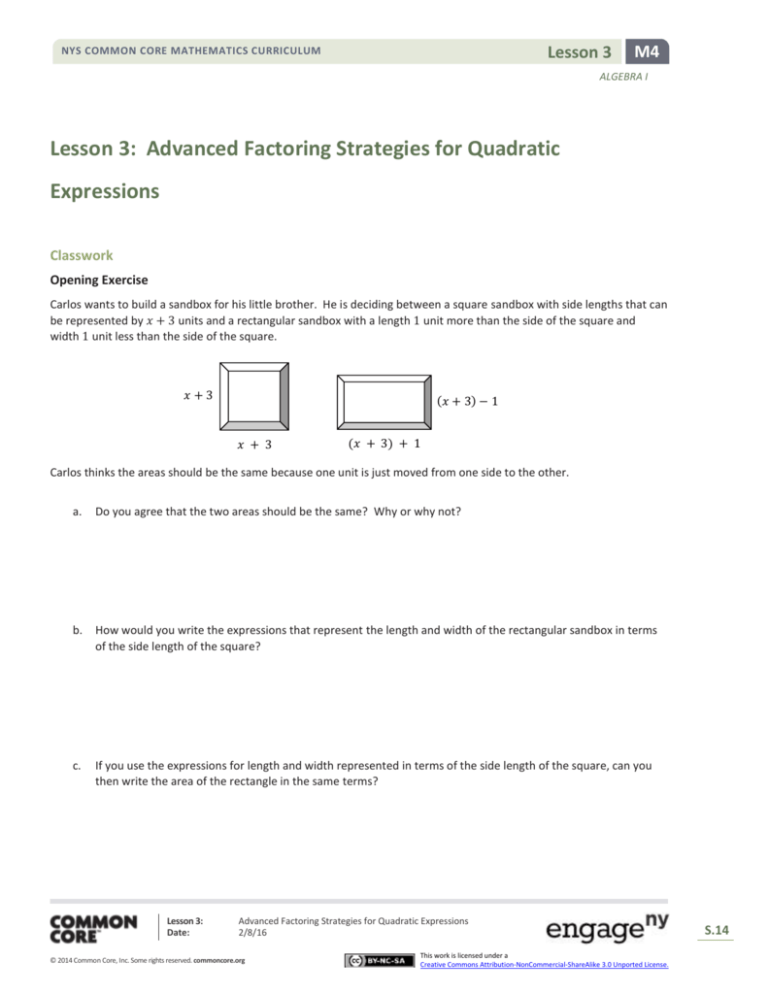
Lesson 3
NYS COMMON CORE MATHEMATICS CURRICULUM
M4
ALGEBRA I
Lesson 3: Advanced Factoring Strategies for Quadratic
Expressions
Classwork
Opening Exercise
Carlos wants to build a sandbox for his little brother. He is deciding between a square sandbox with side lengths that can
be represented by 𝑥 + 3 units and a rectangular sandbox with a length 1 unit more than the side of the square and
width 1 unit less than the side of the square.
𝑥+3
(𝑥 + 3) − 1
𝑥 + 3
(𝑥 + 3) + 1
Carlos thinks the areas should be the same because one unit is just moved from one side to the other.
a.
Do you agree that the two areas should be the same? Why or why not?
b.
How would you write the expressions that represent the length and width of the rectangular sandbox in terms
of the side length of the square?
c.
If you use the expressions for length and width represented in terms of the side length of the square, can you
then write the area of the rectangle in the same terms?
Lesson 3:
Date:
Advanced Factoring Strategies for Quadratic Expressions
2/8/16
© 2014 Common Core, Inc. Some rights reserved. commoncore.org
This work is licensed under a
Creative Commons Attribution-NonCommercial-ShareAlike 3.0 Unported License.
S.14
Lesson 3
NYS COMMON CORE MATHEMATICS CURRICULUM
M4
ALGEBRA I
d.
How can this expression be seen as the product of a sum and difference: (𝑎 + 𝑏)(𝑎 − 𝑏)?
e.
Can you now rewrite the area expression for the rectangle as the difference of squares:
(𝑎 + 𝑏)(𝑎 − 𝑏) = 𝑎2 − 𝑏 2 ?
f.
Look carefully at your answer to the last question. What does it tell you about the areas of the two shapes?
g.
Can you verify that our algebra is correct using a diagram or visual display?
Lesson 3:
Date:
Advanced Factoring Strategies for Quadratic Expressions
2/8/16
© 2014 Common Core, Inc. Some rights reserved. commoncore.org
This work is licensed under a
Creative Commons Attribution-NonCommercial-ShareAlike 3.0 Unported License.
S.15
Lesson 3
NYS COMMON CORE MATHEMATICS CURRICULUM
M4
ALGEBRA I
Example 1
In Lesson 2, we saw that factoring is the reverse process of multiplication. We factor a polynomial by reversing the
distribution process.
Consider the following example of multiplication:
(𝑥 + 3)(𝑥 + 5) 𝑥 2 + 5𝑥 + 3𝑥 + 15
𝑥 2 + 8𝑥 + 15
When we compare the numbers in the factored form with the numbers in the expanded form, we see that 15 is the
product of the two numbers (3 ⋅ 5) and 8 is their sum (3 + 5). The latter is even more obvious when we look at the
expanded form before the like terms are combined.
Can you explain why that relationship exists between the numbers in the factors and the numbers in the final expanded
form?
Example 2
Now compare the expansion of this binomial product to the one above:
(2𝑥 + 3)(1𝑥 + 5)
2𝑥 2 + 10𝑥 + 3𝑥 + 15
2𝑥 2 + 13𝑥 + 15
In the expression lying between the two arrows (before the like terms are combined), we can see the coefficients of the
“split” linear terms (+10𝑥 + 3𝑥). Also notice that for this example, we have coefficients on both 𝑥-terms in the factors
and that one of the coefficients is not 1. We have 2 and 1 as the factors of the leading coefficient in the expanded form
and 3 and 5 as the factors of the constant term. Get ready for quadratic expressions in factored form where neither of
the 𝑥-term coefficients are 1.
a.
How is this product different from the first example? How is it similar?
b.
Why are the “split” linear terms different in the two examples?
Lesson 3:
Date:
Advanced Factoring Strategies for Quadratic Expressions
2/8/16
© 2014 Common Core, Inc. Some rights reserved. commoncore.org
This work is licensed under a
Creative Commons Attribution-NonCommercial-ShareAlike 3.0 Unported License.
S.16
Lesson 3
NYS COMMON CORE MATHEMATICS CURRICULUM
M4
ALGEBRA I
c.
Now that we have four different numbers (coefficients) in each form of the expression, how can we use the
numbers in the expanded form of the quadratic expression on the right to find the numbers in the factors on
the left?
d.
Now we need to place those numbers into the parentheses for the factors so that the product matches the
expanded form of the quadratic expression. Here is a template for finding the factors using what we call the
product-sum method:
(___𝑥 ± __)(___𝑥 ± ___) [We have four number places to fill in this factor template.]
(___𝑥 ± 3 )(___𝑥 ± 5 ) [We know that the 3 and 5 are the correct factors for 15, so we start there.]
( 2 𝑥 ± 3 )( 1 𝑥 ± 5 ) [We know that 2 and 1 are the only factors of 2, with the 2 opposite the 5 so that
the distribution process gives us 10𝑥 for one product.]
( 2𝑥 + 3 )( 𝑥 + 5 )
[Finally, we know, at least for this example, that all the numbers are positive.]
Example 3
Now try factoring a quadratic expression with some negative coefficients: 3𝑥 2 − 𝑥 − 4.
(___𝑥 ± ___)(___𝑥 ± ___)
[We have four number places to fill in this factor template.]
(___𝑥 ± 1 )(___𝑥 ± 4 )
[We know that ±1 and ±4 or ±2 and ±2 are the only possible factors for the constant
term, −4, so we start there. Try 1 and 4 to start, and if that does not work, go back
and try ±2 and ±2. We know that only one of the numbers can be negative to make
the product negative.]
( 1 𝑥 ± 1 )( 3 𝑥 ± 4 )
[We know that 3 and 1 are the only factors of 3. We also know that both of these are
positive (or both negative). But we do not know which positions they should take, so
we will try both ways to see which will give a sum of −1.]
( 𝑥 + 1 )( 3𝑥 − 4 )
[Finally, we determine the two signs needed to make the final product 3𝑥 2 − 𝑥 − 4.]
Lesson 3:
Date:
Advanced Factoring Strategies for Quadratic Expressions
2/8/16
© 2014 Common Core, Inc. Some rights reserved. commoncore.org
This work is licensed under a
Creative Commons Attribution-NonCommercial-ShareAlike 3.0 Unported License.
S.17
Lesson 3
NYS COMMON CORE MATHEMATICS CURRICULUM
M4
ALGEBRA I
Exercises
For Exercises 1–6, factor the expanded form of these quadratic expressions. Pay particular attention to the negative and
positive signs.
1.
3𝑥 2 − 2𝑥 − 8
2.
3𝑥 2 + 10𝑥 − 8
3.
3𝑥 2 + 𝑥 − 14
[Notice that there is a 1 as a coefficient in this one.]
4.
2𝑥 2 − 21𝑥 − 36
[This might be a challenge. If it takes too long, try the next one.]
5.
−2𝑥 2 + 3𝑥 + 9
[This one has a negative on the leading coefficient.]
6.
𝑟2 + 𝑟 +
6
4
9
16
[We need to try one with fractions, too.]
Lesson 3:
Date:
Advanced Factoring Strategies for Quadratic Expressions
2/8/16
© 2014 Common Core, Inc. Some rights reserved. commoncore.org
This work is licensed under a
Creative Commons Attribution-NonCommercial-ShareAlike 3.0 Unported License.
S.18
Lesson 3
NYS COMMON CORE MATHEMATICS CURRICULUM
M4
ALGEBRA I
For Exercises 7–10, use the structure of these expressions to factor completely.
7.
100𝑥 2 − 20𝑥 − 63
8.
𝑦 4 + 2𝑦 2 − 3
9.
9𝑥 2 − 3𝑥 − 12
10. 16𝑎2 𝑏 4 + 20𝑎𝑏 2 − 6
Lesson 3:
Date:
Advanced Factoring Strategies for Quadratic Expressions
2/8/16
© 2014 Common Core, Inc. Some rights reserved. commoncore.org
This work is licensed under a
Creative Commons Attribution-NonCommercial-ShareAlike 3.0 Unported License.
S.19
Lesson 3
NYS COMMON CORE MATHEMATICS CURRICULUM
M4
ALGEBRA I
Lesson Summary
QUADRATIC EXPRESSION: A polynomial expression of degree 2 is often referred to as a quadratic expression.
Some quadratics are not easily factored. The following hints will make the job easier:
In the difference of squares 𝑎2 − 𝑏 2 , either of these terms 𝑎 or 𝑏 could be a binomial itself.
The product-sum method is useful but can be tricky when the leading coefficient is not 1.
Trial and error is a viable strategy for finding factors.
Check your answers by multiplying the factors to ensure you get back the original quadratic expression.
Problem Set
Factor the following quadratic expressions.
1.
3𝑥 2 − 2𝑥 − 5
2.
−2𝑥 2 + 5𝑥 − 2
3.
5𝑥 2 + 19𝑥 − 4
4.
4𝑥 2 − 12𝑥 + 9
5.
3𝑥 2 − 13𝑥 + 12
[This one is tricky, but look for a special pattern.]
Lesson 3:
Date:
Advanced Factoring Strategies for Quadratic Expressions
2/8/16
© 2014 Common Core, Inc. Some rights reserved. commoncore.org
This work is licensed under a
Creative Commons Attribution-NonCommercial-ShareAlike 3.0 Unported License.
S.20

